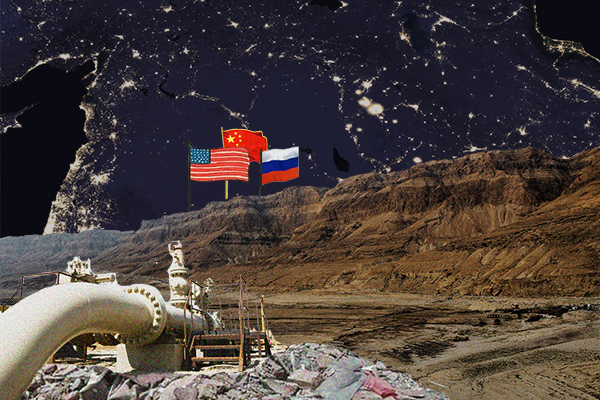Today three external powers –the US, China and Russia– are the leading players behind great power rivalry in the Middle East. The consequences of the Arab Uprisings, the decline of the post-Cold War order and increasing global rivalry between great powers have led to this regional competition anew.
“The rivalry of great powers, combined with the already existing regional rifts between Iran, Saudi Arabia-led Sunni Arab states, Israel and Turkey, has put its negative mark on the region’s stability”.
The Middle East –with its rich hydrocarbons, strategic geopolitical location, key international sea lanes and choke points, from the Suez Canal and Bab al-Mandab to the Strait of Hormuz– has been a natural location for great power rivalry for years. The consequences of the Arab uprisings and the decline of the post-Cold War order have led to this competition anew. The rivalry of great powers, combined with the already existing regional rifts between Iran, Saudi Arabia-led Sunni Arab states, Israel and Turkey, has put its negative mark on the region’s stability.
At the intersection of great-power rivalry and regional competition in the Middle East there are at least five trends that shape the current Middle Eastern strategic environment:
- Protracted conflicts in the region, from wars in Syria to Libya and Yemen.
- The ongoing rivalry between the Saudi-led coalition and Iran and its proxies.1
- Accordingly, the strained US-Iran dynamics remain at the centre of regional instability with a further potential to escalate into violent incidents such as Iran’s downing of a US drone, attacks on the US base in Iraq and the US killing of key Islamic Revolutionary Guard Corps (IRGC) leader Qassim Soleimani.2
- The growing international agency of smaller Arab Gulf states (Qatar and the United Arab Emirates amongst others) –and the intra GCC crisis of 2017–.3
- The ‘known unknown’ of the economic fallout of the COVID-19 pandemic and its potential effects on the security of the Middle East.
These five factors will likely remain crucial as not only will they affect the regions’ strategic outlook but also influence the shape of great power rivalry in the Middle East between the US, China and Russia.
According to the 2017 US National Security Strategy issued by the Trump Administration, ‘great power competition has returned’ and, more specifically, China and Russia ‘challenge American power, influence and interests, attempting to erode American security and prosperity’.4 As the US officially changed its foreign policy focus to great power rivalry, naming China and Russia as its foremost competitors, the Middle Eastern region has become of increased strategic interest to both Beijing and Moscow and will remain a significant feature of competition also during Joe Biden’s presidency.5
“As the US officially changed its foreign policy focus to great power rivalry, naming China and Russia as its foremost competitors, the Middle Eastern region has become of increased strategic interest to both Beijing and Moscow (…)”.
It is worth pointing out the last two US Administrations (Obama and Trump) have sent ambiguous signals regarding the US commitment to peace and security in the Middle East. As far as credibility is concerned, Obama’s hesitation to intervene in Syria and Trump’s surprising decision to withdraw US troops from the country met with a particularly negative reception from the US’s regional allies. They slowly but steadily became concerned about the US presence in the Middle East. Thus, it should be little or no surprise that due to real or perceived US disengagement from the region, local powers have started to question how much longer the US will remain committed to protecting regional energy resources and sea lanes.6 Despite its weakening regional position, the US remains the strongest external force in the Middle East. Washington’s political and military power, together with a long diplomatic tradition in the region, and the support of local allies (including Israel, Saudi Arabia and the United Arab Emirates) have allowed the US to maintain a leading force in the region for years. Solely from the security standpoint, the US position in the region is difficult to challenge by any external or local powers. The outcome of the 2020 US presidential elections might change some features of its policy in the Middle East but it is unlikely to result in a tectonic shift with regard to the country’s role in the region.
The latest Russian Middle East policy could be viewed as a strategy with limited objectives and relatively modest resources. The Kremlin seems to view its regional behaviour as a chance to build up international prestige without any robust engagement, as shown in its military involvement in the Syrian war, with paramilitaries present in both Syria and Libya, a tightening of economic ties with Egypt and Algeria, and increasing arms sales to regional powers. Furthermore, Moscow’s diplomatic, economic and military presence in the Middle East should be understood not only in terms of a response to power vacuums and the weakness of external actors in the region, but also in the context of a more proactive domestically-driven Kremlin approach towards international affairs in its attempts to achieve again a status of great power and remake the international order.7
“Moscow’s diplomatic, economic and military presence in the Middle East should be understood not only in terms of a response to power vacuums and the weakness of external actors in the region, but also in the context of a more proactive domestically-driven Kremlin approach towards international affairs (…)”.
With Russia’s intervention in Syria providing successful support to Bashar al-Assad’s regime against all Western pressure, Moscow strengthened itself in the regional great-power competition. In the aftermath of Russian military engagement in the Syrian war, Moscow has seen a growing interest in Russian weaponry from regional actors (such as Egypt, Qatar and Saudi Arabia) and an increased activity in its diplomatic efforts in the region (eg, the Astana process).8 Apart from Russia’s officially acknowledged interests in the region –like preventing or countering the rise of radical jihadist movements, expanding economic cooperation and defending Russian energy interests–, the Kremlin has sought to position itself as a formidable power in the Middle East with which the West, and especially the US, must reckon. Therefore, Russia’s goals from the perspective of great-power rivalry aim to: (1) force the US to acknowledge the legitimacy of its aims and status as an equal global superpower; (2) challenge NATO’s southern flank in the Levant and the Eastern Mediterranean by acquiring (or re-establishing) military bases in Syria and actively seeking to establish them in Egypt and Libya; and (3) reinforce its working partnership with Iran and improve its relations with Turkey, keeping Ankara at odds with some of the other NATO allies.
So far, Moscow seems to be content with its new position in the Middle East. It has been perceived by many regional actors as a mediator and an alternative weapons supplier to the US, the UK and France. What is even more important for Russia’s position in the Middle East after the Arab Uprisings is that Moscow is being seen as a status quo power, committed to preserve ties with autocratic regimes and royal families of the region rather than supporting forces for political change.
Traditionally, the Chinese authorities have seen the Middle East as a major supplier of natural gas and crude oil. Although China’s interests in the Middle East were mostly of an economic nature, they have recently moved on to incorporate strategic concerns as well. The Belt and Road Initiative (BRI) has become one of the elements that is noticeably expanding Chinese influence in the Middle East (and North Africa).9 This, in turn, has raised the stakes in the regional power rivalry among the key outside powers.
“(…) Beijing persistently managed to become one of the central commercial players in the Middle East, trading with regional powers in the Gulf, the Levant and North Africa”.
Yet even in merely economic terms, Beijing persistently managed to become one of the central commercial players in the Middle East, trading with regional powers in the Gulf, the Levant and North Africa.10 In 2019, for instance, China was Saudi Arabia’s leading trading partner and Israel’s second-largest trading partner. Chinese interests have mostly involved oil and energy resources but there has also been a military and technological angle to its presence in the Middle East. For instance, Beijing has filled a niche in limited arms sales to the Gulf Arab states, supplying Saudi Arabia with missiles and UAV technology. On the other hand, China has maintained close security ties with Iran as well, a fact that should not go unnoticed in a perspective of global US-China rivalry and extremely tense US-Iranian relations (especially following the Trump Administration’s withdrawal from the JCPOA).
This openness to do business on the both sides of the Gulf stems from Beijing’s rule to keep up its policy of non-intervention and neutrality with regard to multiple conflicts among its Middle East trade partners, especially the fierce Iranian-Saudi regional competition and the crisis between Saudi Arabia and its allies (the UAE, Bahrain and Egypt) and Qatar. Moreover, China has not challenged –at least so far– the US military dominance in the region and Washington’s special role as the key external power that provides stability and maritime security in the Gulf.11 Last but not least, China’s strategy in the region has not been backed up by a military presence. Beijing has clearly focused on the economic dimension of power projection in the Middle East, refraining from any direct military presence that would inevitably trigger a strong reaction in Washington. In case Beijing decides to expand and improve its military base in Djibouti, the status quo in the region could be altered. Djibouti already hosts US and French military outposts on its territory and can easily become a location where competition between external and regional powers can become manifest.12
“With the current political and economic situation amplified by the effects of COVID-19, the great power rivalry in the Middle East can slow down in the short term but in the longer run the competition between the US, China and Russia might intensify (…)”.
With the current political and economic situation amplified by the effects of COVID-19, the great power rivalry in the Middle East can slow down in the short term but in the longer run the competition between the US, China and Russia might intensify given the confrontational rhetoric of these powers and the nationalistic tendencies magnified by the pandemic. Beijing will play its ‘long’ game in the region by increasing its economic ties and investments across the Middle East. But Chinese strategy is likely to adopt a more subtle and indirect approach towards its partners as its policy in the Middle East will probably ‘remain pragmatic and restrained’.13 Moscow will try to maintain its diplomatic position in the region while keeping its eye on its military presence in Syria and Libya. Additionally, should the situation allow, Russia is ready to expand its weapons exports to the traditional regional allies of the US (Iraq, Qatar, Saudi Arabia and Turkey). China and Russia share an interest in breaking US naval dominance in the Gulf and in resisting US sanctions against Iran. Both Beijing and Moscow share a common goal of unseating the US as the global leader.14 Establishing diplomatic, economic and eventually military strongholds in the Middle East would be necessary steps in that direction.
Washington, on the other hand, is unlikely to surrender its role in the region and will remain the strongest external military force in the Middle East, even though its relative power in the region has been declining, the recent developments in the Middle East –including rapprochement between Israel, the UAE and Bahrain (the Abraham Accords)– might strengthen Washington’s position, especially in the context of forming an anti-Iranian coalition.
Finally, given the austerity and cautiousness of external powers as a result, to a great extent, of the COVID-19 pandemic, the driving forces underlying the rivalry will be shaped by regional powers such as Iran, Saudi Arabia, Israel, Turkey and the rising power of the UAE and its competitors in the Middle East.
1 At present, Iran operates through proxies in Syria, Lebanon, Iraq and Yemen and has been encouraging these groups to launch missile attacks on Israel and Saudi Arabia. See Ariane M. Tabatabai & Colin P. Clarke (2019), ‘Iran’s proxies are more powerful than ever’, Foreign Policy, 16/X/2019.
2 Ian Williams (2020), ‘Uncomfortable lessons: reassessing Iran’s missile attack’, Center for Strategic and International Studies, 6/II/2020.
3 Cinzia Bianco (2019), ‘Cracks in the Saudi-Emirati alliance?’, European Council on Foreign Relations, 13/IX/2019.
4 Donald Trump (2017), ‘National Security Strategy of the United States’, Washington DC, December.
5 For more detailed and global perspective of the US’s great power competition logic see: Elbridge A. Colby & A. Wess Mitchell (2020), ‘The age of great-power competition, how the Trump Administration refashioned American strategy”, Foreign Affairs, January/February.
6 William F. Wechsler (2019), ‘US withdrawal from the Middle East: perceptions and reality’, Atlantic Council.
7 Wojciech Michnik (2020), ‘Russia’s new strategic calculus in the Middle East’, in M. Kaczmarski, W. Michnik A. Monaghan, M. Ozawa & V. Rotaru, Russia’s Emerging Global Ambitions, NATO Defence College Research Paper, nr 11, July, p. 23.
8 For instance, in 2019 some of key the Gulf States expressed a direct interest in purchasing advanced Russian military systems. The discussions between Russia and both Saudi Arabia and Qatar about S-400 systems are noteworthy, especially since Russia has had rather a low record of arms exports to these states. See Emma Soubrier (2020), ‘Gulf security in a multipolar world: power competition, diversified cooperation’, Arab Gulf States Institute in Washington, Washington, p. 3.
9 Jonathan Fulton (2019), ‘China’s changing role in the Middle East’, Atlantic Council, June.
10 For more on China’s role in the region see Camille Lons (2019), ‘China’s great game in the Middle East’, European Council on Foreign Relations, Policy Brief, 21/X/2019.
11 Nader Habibi & Hans Yue Zhu (2020), ‘What CPEC means for China’s Middle East relations’, The Diplomat, 22/I/2020.
12 For more information see Jean-Pierre Cabestan (2020), ‘China’s military base in Djibouti: a microcosm of China’s growing competition with the United States and new bipolarity’, Journal of Contemporary China, vol. 29, nr 125, p. 731-747.
13 Henrik Stålhane Hiim & Stig Stenslie (2020), ‘China’s realism in the Middle East’, Survival, vol. 61, nr 6, December 2019-January 2020, p. 154.
14 Jamsheed K. Choksy & Carol E.B. Choksy (2020), ‘China and Russia have Iran’s back’, Foreign Affairs, 17/XI/2020.



